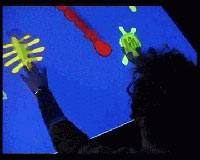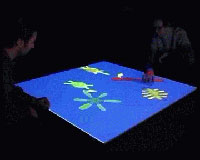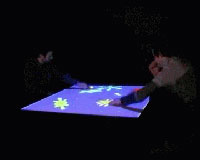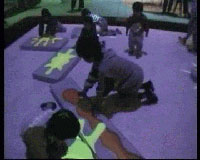








|
Masaki Fujihata - Kiyoshi Furukawa - Wolfgang Münch
Notes on Small Fish, 1999
Interactive installation, 1999
The world of abstract expression pioneered in twentieth century art by Schoenberg in music and Kandinsky and others in painting can now be given concrete expression thanks to the interactive media made possible by computer technology.
By now we have become quite accustomed to thinking of dots and lines in relation to music, but we must still use our imagination before we can hear music in painting. Indeed the whole point is to use our imagination to anticipate that music. Watching a movie about painting while playing music can only cause our imagination to shrink.
The primary theme of this work is "interaction." The production of meaning in semiotic theory requires a mutual interaction of signifying codes. If we can create a space in which the meaning created by painterly elements such as dots, lines, and colors interacts with the meanings created by the tone and pitch of instruments it should be possible to have a concrete experience of and appreciation for the space of abstract meaning. The point is not to engage in some kind of cerebral interaction after each element of the painting has been decoded as one might look at a painting, but to draw the meaning out through direct interaction with the images. Thought does not follow experience, it is experience itself. That is the primary condition of the interactive environment.
 |
 |
Our "Small Fish" is an attempt to create such a space. The dots and lines placed on the computer's electronic canvas have elements of musical notation about them, but are also instruments for the interactive production of sound.
Initially the user may experience some difficulty understanding the various meanings of the symbols on the screen, but those meanings gradually become clear as he or she begins to manipulate them. Eventually the sound sequences generated will begin to sound like "music." (In any case we know that our brains are always trying to distinguish music in noise. The way in which people begin to hear music is thus an indication of the depth of their musical culture and background.) The search for meaning is made more complex here, going beyond mere "symbols" with the addition of music. The pleasures of movement and of music yield subtlety to each other in a common progression.
 |
 |
There is a lot of talk of the infinite possibilities of interactive art using computers. The free combination of a range of elements is said to astonish us with bizarre and unpredictable happenings. All of this may be true in a laboratory setting, but it is quite another matter to produce chance happenings and offer them up to an audience as art. In this project we felt it was extremely important to find a way to delimit the background and potential of each element in the interest of the generation of meaning. The fascination of relations emerging over time derives from the extraordinary complexity which can arise even within a set of rigid limitations.
"Small Fish" is designed so that users will come to understand the musical structure proposed by Furukawa through precisely those limitations. Repetitions, rising and falling sequences, the left and right hand of the piano--all classic musical structures--can be heard amidst the chaos. But no amount of manipulation will cause them to coalesce into perfect music.
The overall effect is like a child thrusting his arms in a running stream, trying to catch a fish.
Masaki Fujihata
| |

